Lost Material Stock in Buildings due to Sea Level Rise from Global Warming: The Case of Fiji Islands
Abstract
1. Introduction
2. Materials and Methods
2.1. Case Study Area
2.2. GIS-Based Digital Inundation Analysis Model (GIS-DIAM)
2.2.1. Elevation Data
2.2.2. Inundation Data
2.2.3. Administrative Boundaries and the Spatial Localization of Buildings
2.2.4. Separation between Urban and Rural Areas
2.3. MSA-Based Construction Material Stocked Model
2.3.1. Construction Types
2.3.2. Material Intensities
2.3.3. Gross Floor Area (GFA)
3. Results
3.1. Results of the GIS-DIAM
3.2. Results of the MSA
4. Discussion
5. Conclusions
5.1. Conclusions
5.2. Limitations and Assumptions
Supplementary Materials
Author Contributions
Funding
Acknowledgments
Conflicts of Interest
References
- IPCC. Global Warming of 1.5 °C; An IPCC Special Report on the impacts of global warming of 1.5 °C above pre-industrial levels and related global greenhouse gas emission pathways, in the context of strengthening the global response to the threat of climate-change, sustainable development, and efforts to eradicate poverty; Masson-Delmotte, V.M., Zhai, P., Pörtner, H.-O., Roberts, D., Skea, J., Shukla, P.R., Pirani, A., Moufouma-Okia, W., Péan, C., Pidcock, R., et al., Eds.; IPCC: Geneva, Switzerland, 2018; In Press. [Google Scholar]
- Church, J.A.; Clark, P.U.; Cazenave, A.; Gregory, J.M.; Jevrejeva, S.A.; Levermann, A.; Merrifield, M.A.; Milne, G.A.; Nerem, R.S.; Nunn, P.D.; et al. Sea Level Change. In Climate Change 2013: The Physical Science Basis; Contribution of Working Group I to the Fifth Assessment Report of the Intergovernmental Panel on Climate Change; Stocker, T.F., Qin, D., Plattner, G.-K., Tignor, M., Allen, S.K., Boschung, J., Nauels, A., Xia, Y., Bex, V., Midgley, P.M., Eds.; Cambridge University Press: Cambridge, UK; New York, NY, USA, 2013. [Google Scholar]
- Dasgupta, S.; Meisner, C.; Laplante, B.; Wheeler, D.; Yan, J. The Impact of Sea Level Rise on Developing Countries; WPS-4136; The World Bank: Washington, DC, USA, 2007. [Google Scholar]
- Barbier, E.B. Climate Change Impacts on Rural Poverty in Low-Elevation Coastal Zones. Estuar. Coast. Shelf Sci. 2015, 165, A1–A13. [Google Scholar] [CrossRef]
- IPCC. Climate Change 2014: Synthesis Report; Contribution of Working Groups I, II and III to the Fifth Assessment Report of the Intergovernmental Panel on Climate Change; IPCC: Geneva, Switzerland, 2014. [Google Scholar]
- Kulp, S.A.; Strauss, B.H. New elevation data triple estimates of global vulnerability to sea-level rise and coastal flooding. Nat. Commun. 2019. [Google Scholar] [CrossRef]
- Climate Change Secretariat. Climate Change: Small Island Developing States; Climate Change Secretariat: Bonn, Germany, 2005. [Google Scholar]
- Golden, C.D.; Allison, E.H.; Cheung, W.W.L.; Dey, M.M.; Halpern, B.S.; McCauley, D.J.; Smith, M.; Vaitla, B.; Zeller, D.; Myers, S.S. Nutrition: Fall in Fish Catch Threatens Human Health. Nature 2016, 534, 317–320. [Google Scholar] [CrossRef] [PubMed]
- Mercer, J.; Kelman, I.; Alfthan, B.; Kurvits, T. Ecosystem-Based Adaptation to Climate Change in Caribbean Small Island Developing States: Integrating Local and External Knowledge. Sustainability 2012, 4, 1908–1932. [Google Scholar] [CrossRef]
- Turvey, R. Vulnerability Assessment of Developing Countries: The Case of Small-island Developing States. Dev. Policy Rev. 2007, 25, 243–264. [Google Scholar] [CrossRef]
- Kurniawan, F.; Adrianto, L.; Bengen, D.G.; Prasetyo, L.B. Vulnerability Assessment of Small Islands to Tourism: The Case of the Marine Tourism Park of the Gili Matra Islands, Indonesia. Glob. Ecol. Conserv. 2016, 6, 308–326. [Google Scholar] [CrossRef]
- Blasiak, R.; Spijkers, J.; Tokunaga, K.; Pittman, J.; Yagi, N.; Österblom, H. Climate Change and Marine Fisheries: Least Developed Countries Top Global Index of Vulnerability. PLoS ONE 2017, 12. [Google Scholar] [CrossRef]
- Gravelle, G.; Mimura, N. Vulnerability Assessment of Sea-Level Rise in Viti Levu, Fiji Islands. Sustain. Sci. 2008, 3, 171–180. [Google Scholar] [CrossRef]
- The World Bank. Climate Vulnerability Assessment: Making Fiji Climate Resilient; The World Bank: Suva, Fiji, 2017. [Google Scholar]
- Wu, S.Y.; Najjar, R.; Siewert, J. Potential Impacts of Sea-Level Rise on the Mid- and Upper-Atlantic Region of the United States. Clim. Chang. 2009, 95, 121–138. [Google Scholar] [CrossRef]
- Heberger, M.; Cooley, H.; Herrera, P.; Gleick, P.H.; Moore, E. The Impacts of Sea-Level Rise on the California Coast; California Climate Change Centre: Oakland, CA, USA, 2009. [Google Scholar]
- Sadler, J.M.; Haselden, N.; Mellon, K.; Hackel, A.; Son, V.; Mayfield, J.; Blase, A.; Goodall, J.L. Impact of Sea-Level Rise on Roadway Flooding in the Hampton Roads Region, Virginia. J. Infrastruct. Syst. 2017, 23, 05017006. [Google Scholar] [CrossRef]
- Hallegatte, S.; Ranger, N.; Mestre, O.; Dumas, P.; Corfee-Morlot, J.; Herweijer, C.; Wood, R.M. Assessing Climate Change Impacts, Sea Level Rise and Storm Surge Risk in Port Cities: A Case Study on Copenhagen. Clim. Chang. 2011, 104, 113–137. [Google Scholar] [CrossRef]
- Ministry of Health and Ministry of Economy. 5- Year to 20- Year National Development Plan for Fiji; Ministry of Health and Ministry of Economy: Suva, Fiji, 2017.
- California Coastal Comission. California Coastal Comission Sea Level Rise Policy Guidance: Interpretive Guidelines for Addressing Sea Level Rise in Local Coastal Programs and Coastal Development Permits; California Coastal Comission: San Francisco, CA, USA, 2015.
- Ministry of Economy. Fiji’s National Adaptation Plan Framework Ministry of Economy; Ministry of Economy: Suva, Fiji, 2017.
- Charan, D.; Kaur, M.; Singh, P. Customary Land and Climate Change Induced Relocation—A Case Study of Vunidogoloa Village, Vanua Levu, Fiji. In Climate Change Adaptation in Pacific Countries Forstering Resilience and Improving the Quality of Life; Leal Filho, W., Ed.; Springer International Publishing: Cham, Switzerland, 2017. [Google Scholar] [CrossRef]
- Fuldauer, L.I.; Ives, M.C.; Adshead, D.; Thacker, S.; Hall, J.W. Participatory Planning of the Future of Waste Management in Small Island Developing States to Deliver on the Sustainable Development Goals. J. Clean. Prod. 2019, 223, 147–162. [Google Scholar] [CrossRef]
- United Nations Environment Programme. Small Island Developing States Waste Management Outlook; United Nations Environment Programme: Nairobi, Kenya, 2019. [Google Scholar] [CrossRef]
- Ali, S.; Darsan, J.; Singh, A.; Wilson, M. Sustainable Coastal Ecosystem Management – An Evolving Paradigm and Its Application to Caribbean SIDS. Ocean Coast. Manag. 2018, 163, 173–184. [Google Scholar] [CrossRef]
- Mackay, S.; Brown, R.; Gonelevu, M.; Pelesikoti, N.; Kocovanua, T.; Iaken, R.; Iautu, F.; Tuiafitu-Malolo, L.; Fulivai, S.; Lepa, M.; et al. Overcoming Barriers to Climate Change Information Management in Small Island Developing States: Lessons from Pacific SIDS. Clim. Policy 2019, 19, 125–138. [Google Scholar] [CrossRef]
- Tanikawa, H.; Fishman, T.; Okuoka, K.; Sugimoto, K. The Weight of Society over Time and Space: A Comprehensive Account of the Construction Material Stock of Japan, 1945–2010. J. Ind. Ecol. 2015, 19, 778–791. [Google Scholar] [CrossRef]
- Tanikawa, H.; Managi, S.; Lwin, C.M. Estimates of Lost Material Stock of Buildings and Roads Due to the Great East Japan Earthquake and Tsunami. J. Ind. Ecol. 2014, 18, 421–431. [Google Scholar] [CrossRef]
- Kleemann, F.; Lehner, H.; Szczypińska, A.; Lederer, J.; Fellner, J. Using Change Detection Data to Assess Amount and Composition of Demolition Waste from Buildings in Vienna. Resour. Conserv. Recycl. 2017, 123, 37–46. [Google Scholar] [CrossRef]
- Miatto, A.; Schandl, H.; Forlin, L.; Ronzani, F.; Borin, P.; Giordano, A.; Tanikawa, H. A Spatial Analysis of Material Stock Accumulation and Demolition Waste Potential of Buildings: A Case Study of Padua. Resour. Conserv. Recycl. 2019, 142, 245–256. [Google Scholar] [CrossRef]
- Cheng, K.L.; Hsu, S.C.; Li, W.M.; Ma, H.W. Quantifying Potential Anthropogenic Resources of Buildings through Hot Spot Analysis. Resour. Conserv. Recycl. 2018, 133, 10–20. [Google Scholar] [CrossRef]
- H2. Main Material for Construction of Walls—Proportion of Wood—Pie Chart—2007 Census (Households). Available online: http://fiji.popgis.spc.int/#z=211120,8600481,1039511,939237;l=en;v=map1 (accessed on 26 November 2018).
- Fiji Bureau of Statistics. Census 2007 Results: Population Size, Growth, Structure, and Distribution; Fiji Bureau of Statistics: Suva, Fiji, 2008.
- Fiji. Available online: https://download.geofabrik.de/australia-oceania/fiji.html (accessed on 22 November 2018).
- ArcGIS—World Imagery Mit Metadaten. Available online: https://www.arcgis.com/home/webmap/viewer.html?webmap=268c1b2fe17842758476f4e002d19ef4&extent=12.0492,52.0048,13.9938,52.8464 (accessed on 30 June 2019).
- Building Statistics December Quarter and Annual 2018. Available online: https://www.statsfiji.gov.fj/index.php/latest-releases/establishment-surveys/building-statistics/931-building-statistics-december-quarter-annual-2018?highlight=WyJidWlsZGluZyIsImFubnVhbCIsMjAxOCwiYW5udWFsIDIwMTgiXQ== (accessed on 30 August 2019).
- Building Statistics—December Quarter & Annual 2017. Available online: https://www.statsfiji.gov.fj/index.php/latest-releases/establishment-surveys/building-statistics/818-building-statistics-december-quarter-and-annual-2017?highlight=WyJidWlsZGluZyIsMjAxN10= (accessed on 30 August 2019).
- Raqona, V. Personal Communication; Geospatial Division of the Ministry of Lands & Mineral Resources Fiji: Suva, Fiji, 2019.
- Caimi, A.; Moles, O.; Joffroy, T.; Serlet, M. Fiji/Baseline Data on Local Building Culture & Coping Strategies; International Centre for Earthen Construction: Villefontaine, France, 2016. [Google Scholar] [CrossRef]
- Habitat for Humanity Fiji. Construction Manual; Habitat for Humanity Fiji: Suva, Fiji, 2013. [Google Scholar]
- Chang, Y.-S. Life Cycle Assessment on the Reduction of Carbon Dioxide Emission of Buildings; Chenggong University: Tainan, Taiwan, 2002. [Google Scholar]
- Nagaoka, K.; Tanikawa, H.; Yoshida, N.; Higashi, O.; Onishi, A.; Feng, S.; Imura, H. Study of Accumulation (Distribution Tendency to the Material Stock of the Construction Sector in All Prefectures and Mega Cities in Japan. Environ. Sci. 2009, 23, 83–88. [Google Scholar]
- Tanikawa, H.; Hashimoto, S. Urban Stock over Time: Spatial Material Stock Analysis Using 4D-GIS. Build. Res. Inf. 2009, 5–6, 483–502. [Google Scholar] [CrossRef]
- Google Maps. Suva City. Available online: https://www.google.com/maps/@-18.1394616,178.424621,3a,75y,96.46h,110.5t/data=!3m7!1e1!3m5!1sAF1QipNCJNPOQ8u1FqqGFOpm5jq-ztenE-FzsWw0-ORt!2e10!3e11!7i5376!8i2688 (accessed on 10 April 2019).
- Fiji Key Facts. Available online: http://thecommonwealth.org/our-member-countries/fiji (accessed on 30 October 2018).
- Pacific Islands Climate Change Assistance Programme. Climate Change the Fiji Islands Response; Pacific Islands Climate Change Assistance Programme: Suva, Fiji, 2005. [Google Scholar]
- Fiji: Building Resilience in the Face of Climate Change. Available online: https://www.unocha.org/story/fiji-building-resilience-face-climate-change (accessed on 23 October 2019).
- USGS Earth Explorer. Available online: https://earthexplorer.usgs.gov/ (accessed on 7 January 2019).
- ALOS Science Project. Available online: https://www.eorc.jaxa.jp/ALOS/en/aw3d30/index.htm (accessed on 7 January 2019).
- Fiji 2017 Population & Housing Census; Fiji Islands Bureau of Statistics: Suva, Fiji, 2018.
- Solutions, Green Cement: Concrete. Available online: https://www.nature.com/news/green-cement-concrete-solutions-1.12460 (accessed on 8 November 2019).
- Barcelo, L.; Kline, J.; Walenta, G.; Gartner, E. Cement and Carbon Emissions. Mater. Struct. 2014, 47, 1055–1065. [Google Scholar] [CrossRef]
- Hansen, T.C. Recycling of Demolished Concrete and Masonry, 1st ed.; CRC Press: London, UK, 1992. [Google Scholar] [CrossRef]
- Oikonomou, N.D. Recycled Concrete Aggregates. Cem. Concr. Compos. 2005, 27, 315–318. [Google Scholar] [CrossRef]
- Tam, V.W.Y. Comparing the Implementation of Concrete Recycling in the Australian and Japanese Construction Industries. J. Clean. Prod. 2009, 17, 688–702. [Google Scholar] [CrossRef]
- Courard, L.; Michel, F.; Delhez, P. Use of Concrete Road Recycled Aggregates for Roller Compacted Concrete. Constr. Build. Mater. 2010, 24, 390–395. [Google Scholar] [CrossRef]
- Schimmoller, V.E.; Taylor Eighmy, T.; Smith, M.; Rohrbach, G.J.; Helms, G.; Van Deusen, C.H.; Almborg, J.A.; Holtz, K.; Wiles, C.; Malasheskie, G. Recycled Materials in European Highway Environments: Uses, Technologies, and Policies; DIANE Publishing: Washington, DC, USA, 2000. [Google Scholar] [CrossRef]
- Herrador, R.; Pérez, P.; Ordónez, J. Use of Recycled Construction and Demolition Waste Aggregate for Road Course Surfacing. J. Transp. Eng. 2012, 138. [Google Scholar] [CrossRef]
- Ormondroyd, G.A.; Spear, M.J.; Skinner, C. The Opportunities and Challenges for Re-Use and Recycling of Timber and Wood Products Within the Construction Sector. In Environmental Impacts of Traditional and Innovative Forest-based Bioproducts; Kutnar, A., Muthu, S., Eds.; Springer: Singapore, 2016; pp. 45–103. [Google Scholar] [CrossRef]
- Hafner, A.; Ott, S.; Winter, S. Recycling and End-of-Life Scenarios for Timber Structures. Mater. Joints Timber Struct. 2014, 9. [Google Scholar] [CrossRef]
- Addis, B.; Addis, W. Building with Reclaimed Components and Materials: A Design Handbook for Reuse and Recycling; Routledge: London, UK, 2006. [Google Scholar]
- Kaziolas, D.N.; Zygomalas, I.; Stavroulakis, G.E.; Baniotopoulos, C.C. Environmental Impact Assessment of the Life Cycle of a Timber Building. In Proceedings of the Fourteenth International Conference on Civil, Structural and Environmental Engineering Computing, Cagliari, Sardinia, Italy, 3–6 September 2013; Topping, B.H.V., Ivány, P., Eds.; Civil-Comp Press: Stirlingshire, Scotland, 2013. Available online: http://repository.edulll.gr/2516 (accessed on 06 November 2019).
- John, S.; Buchanan, A. Review of End-of-Life Options for Structural Timber Buildings in New Zealand and Australia; University of Canterbury: Christchurch, New Zealand, 2013; Available online: http://hdl.handle.net/10092/10296 (accessed on 06 November 2019).
- Macineasa, S.G.; Entuc, I.S.; Taranu, N.; Florenta, I.; Secu, A. Environmental Performances of Different Timber Structures for Pitched Roofs. J. Clean. Prod. 2018, 175, 164–175. [Google Scholar] [CrossRef]
- Tam, V.W.Y.; Tam, C.M. A Review on the Viable Technology for Construction Waste Recycling. Resour. Conserv. Recycl. 2006, 47, 209–221. [Google Scholar] [CrossRef]
- McNamara, K.E.; Des Combes, H.J. Planning for Community Relocations Due to Climate Change in Fiji. Int. J. Disaster Risk Sci. 2015, 6, 315–319. [Google Scholar] [CrossRef]
- Switalski, T.; Bissonette, J.; DeLuca, T.; Luce, C.; Madej, M. Benefits and Impacts of Road Removal. Front. Ecol. Environ. 2004, 2. [Google Scholar] [CrossRef]
- Nguyen, T.C.; Fishman, T.; Miatto, A.; Tanikawa, H. Estimating the Material Stock of Roads: The Vietnamese Case Study. J. Ind. Ecol. 2019, 23, 663–673. [Google Scholar] [CrossRef]
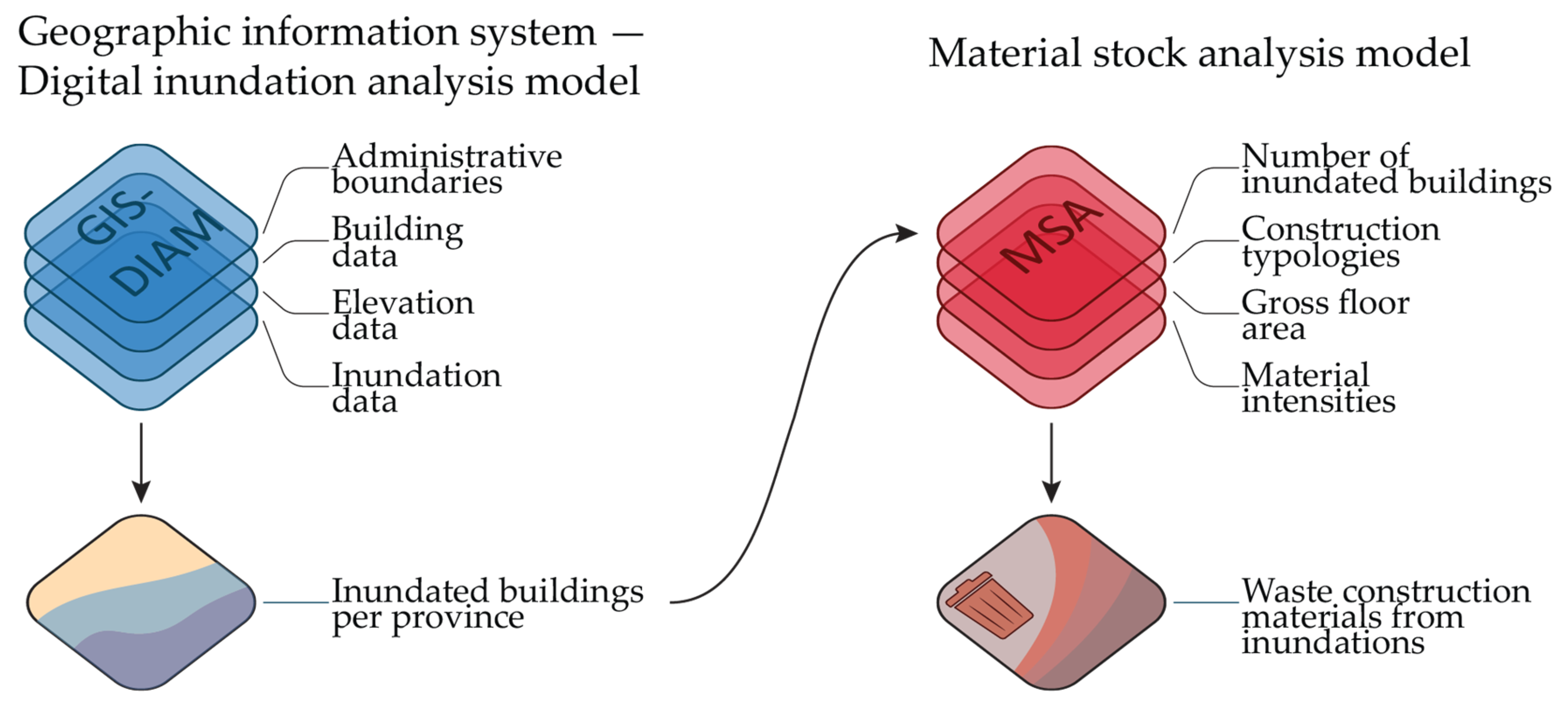
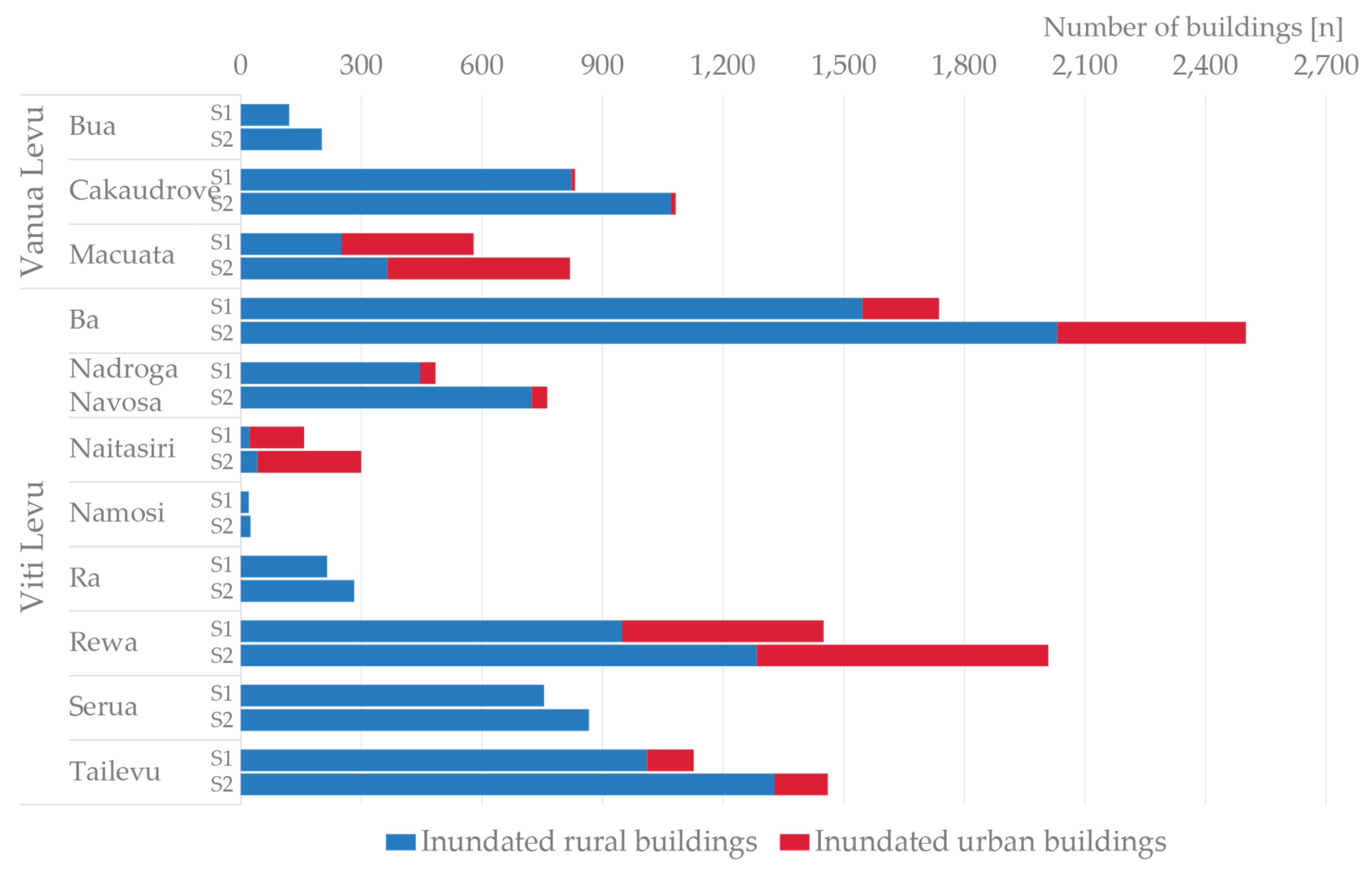
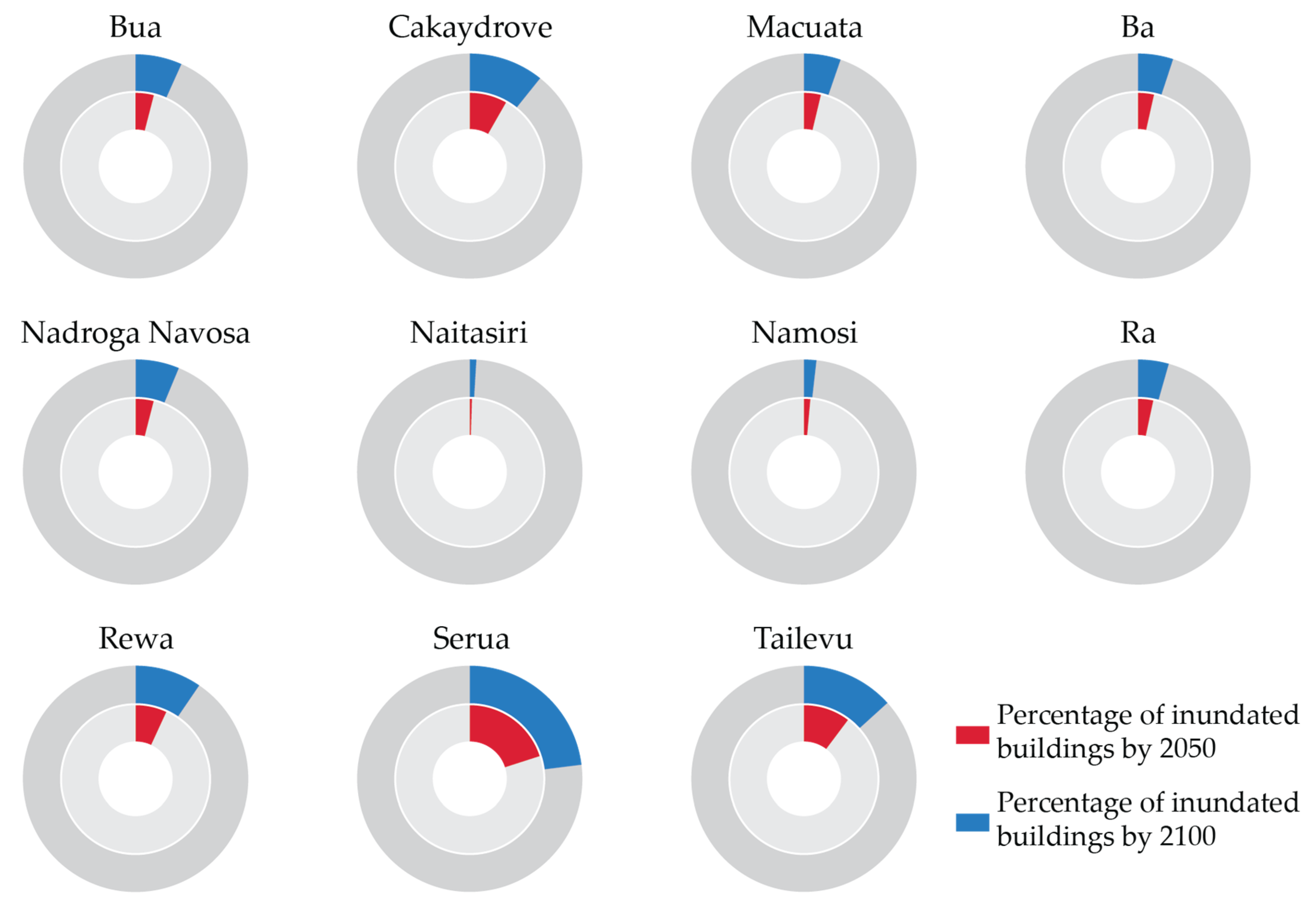
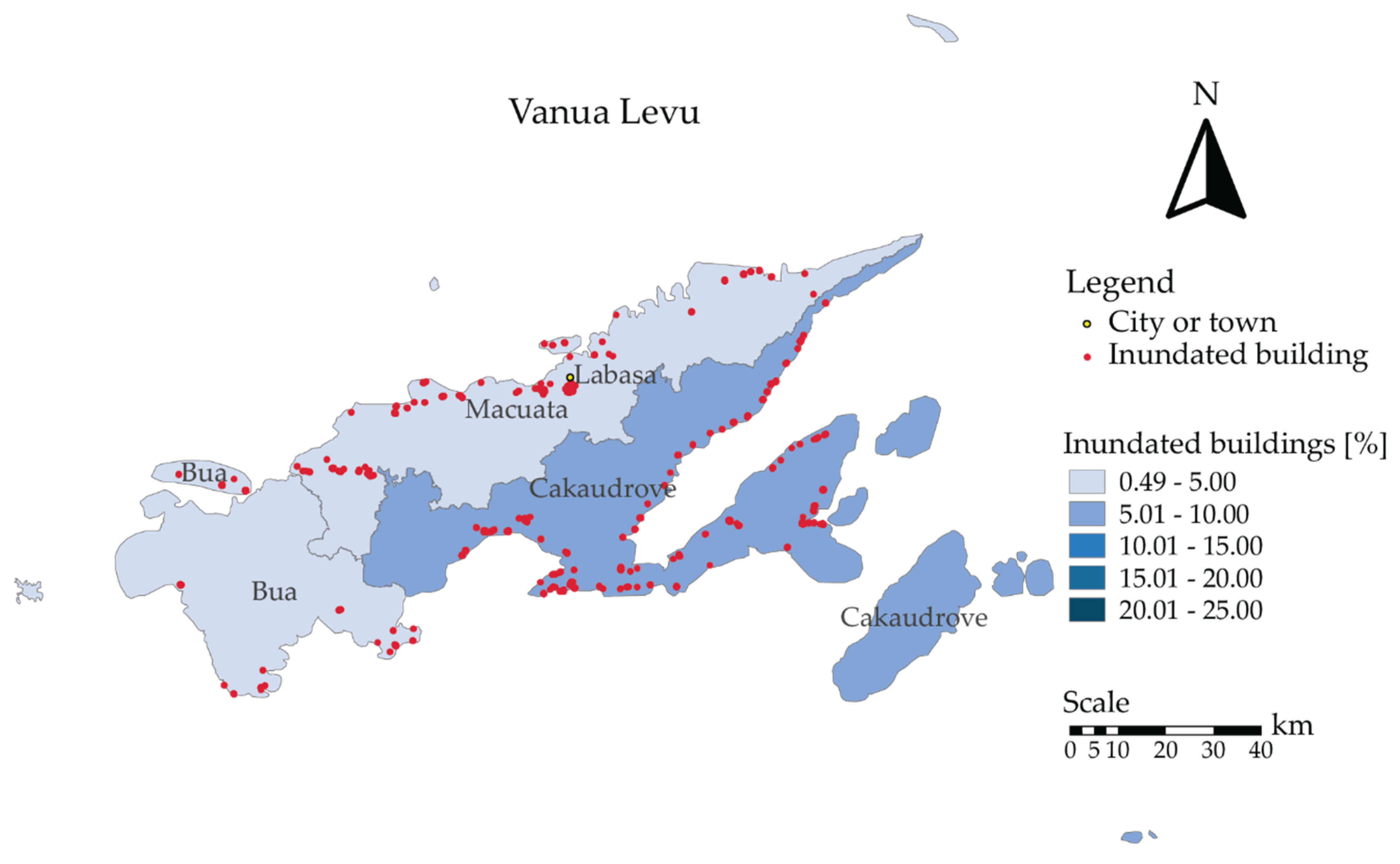
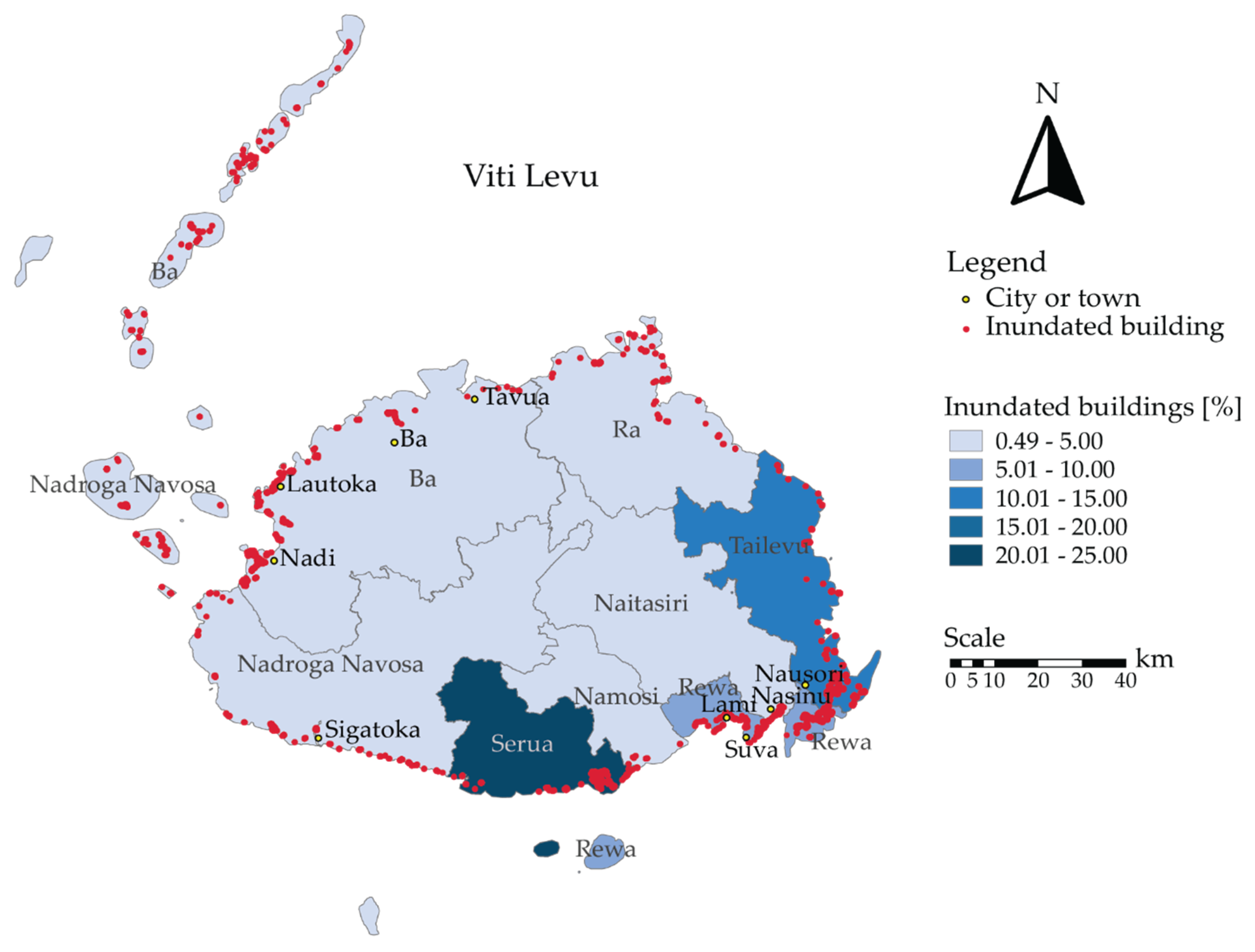
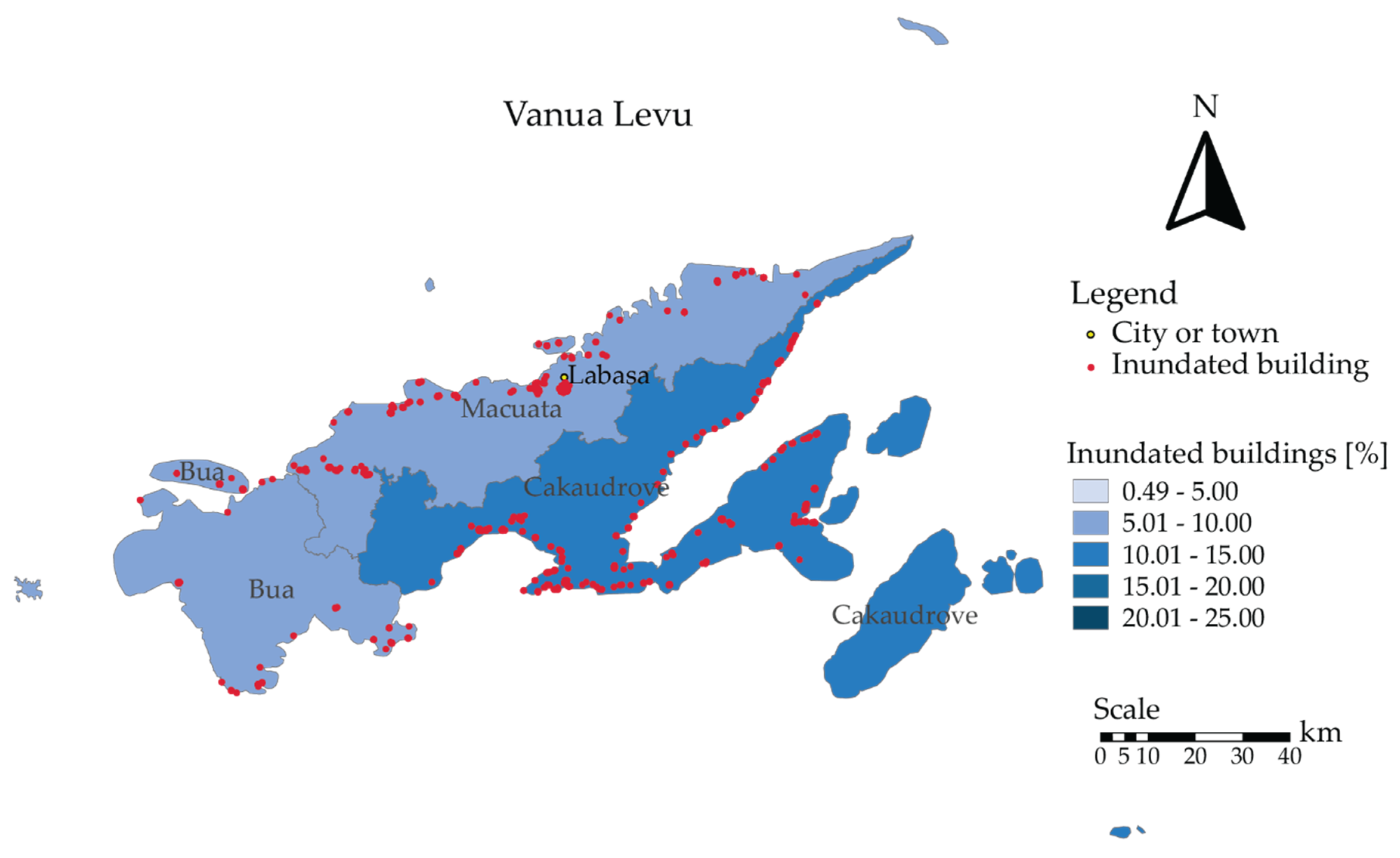
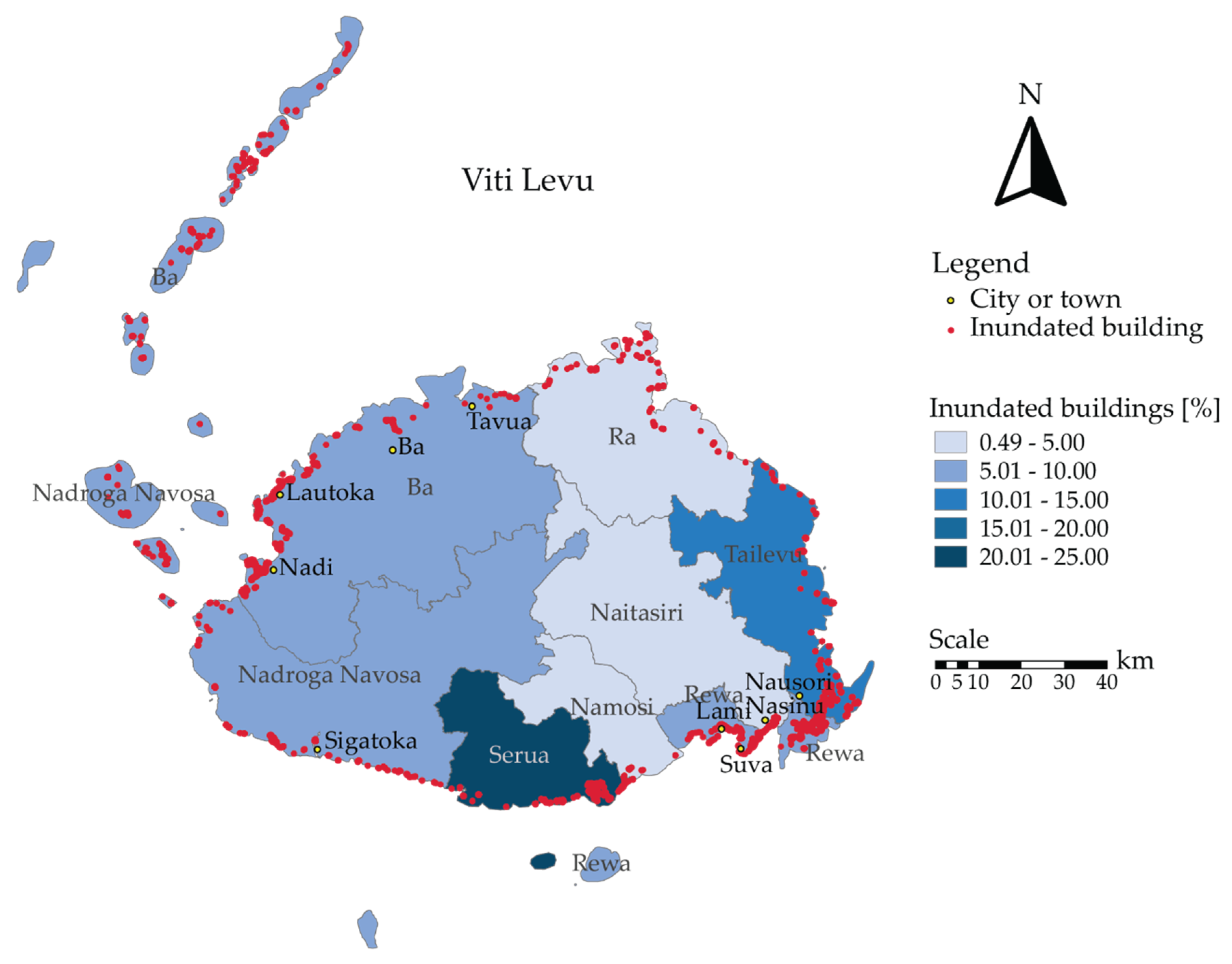
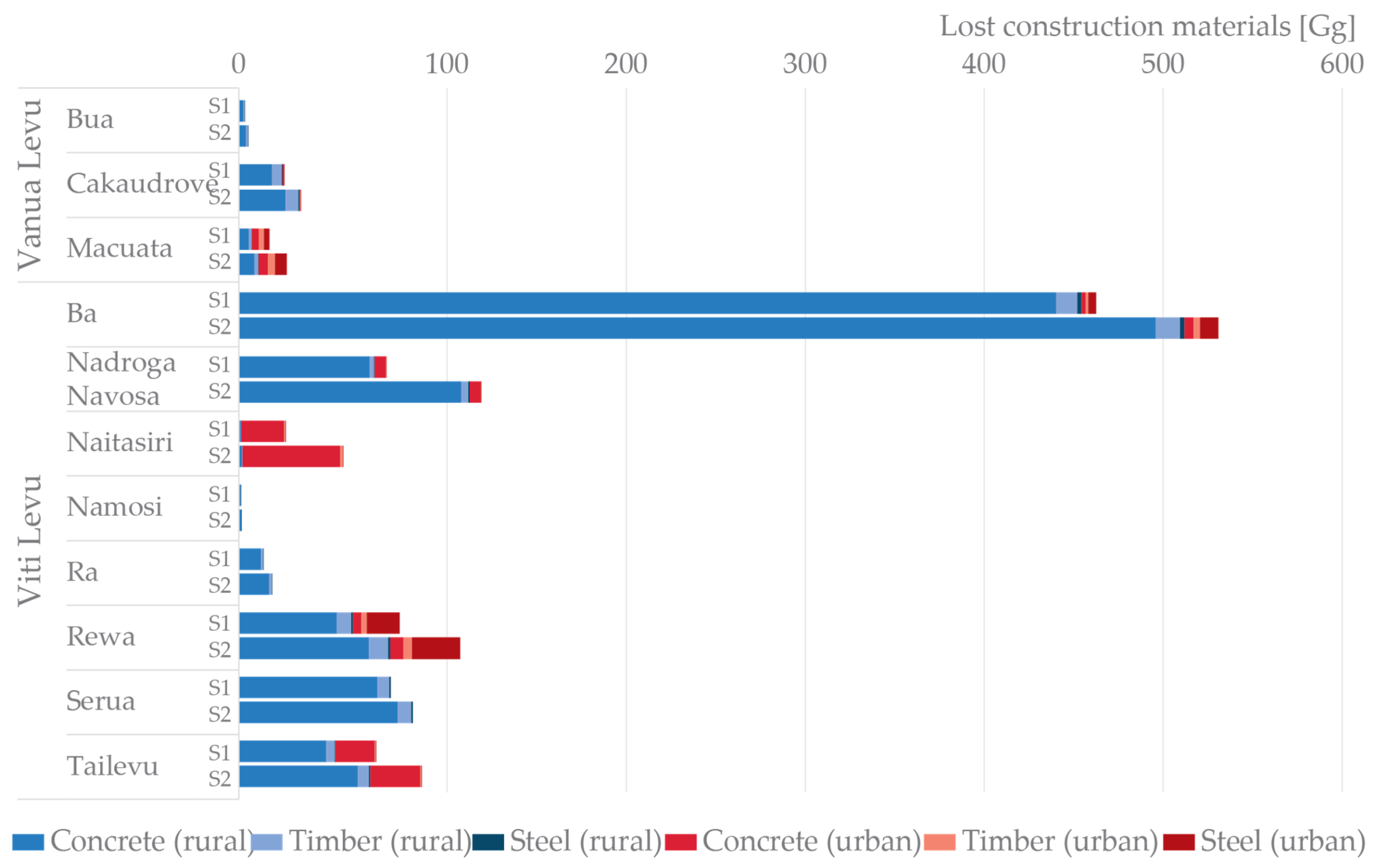
| Area of Interest | Specification | Reference |
|---|---|---|
| Administrative boundaries | Enumerations | [32] |
| Provinces | [32] | |
| Towns and Cities | [33] | |
| Building data | Open Street Map data | [34] |
| Satellite imagery | [35] | |
| Buildings per province | [36,37] | |
| Elevation data | Government data | [38] |
| Inundation data | Permanent sea level rise based on Intergovernmental Panel of Climate Change (IPCC) prediction | [2] |
| Construction typologies | Construction types commonly used on Fiji | [39] |
| Gross floor area | Area of a building | [34] |
| Number of floors in urban areas | Please refer to Supplementary Information Table S1 for the references on the determination of the number of floors within urban areas | |
| Material intensities | Material intensities in kg/m² | [28,31,39,40,41,42,43,44] |
| Spatial distribution per province and construction type | [32] |
| Construction Type | Layer | Concrete | Steel | Timber |
|---|---|---|---|---|
| Cement bricks | Foundation | 1200 | 0 | 0 |
| Wall | 624 | 0 | 0 | |
| Roof | 0 | 5 | 1 | |
| Total | 1824 | 5 | 1 | |
| Reinforced concrete | Total | 1416 | 104 | 0 |
| Steel cladded | Foundation | 108 | 0 | 56 |
| Wall | 0 | 4 | 4 | |
| Roof | 0 | 4 | 1 | |
| Total | 108 | 8 | 61 | |
| Timber cladded | Foundation | 108 | 0 | 56 |
| Wall | 0 | 0 | 36 | |
| Roof | 0 | 5 | 1 | |
| Total | 108 | 5 | 94 |
© 2020 by the authors. Licensee MDPI, Basel, Switzerland. This article is an open access article distributed under the terms and conditions of the Creative Commons Attribution (CC BY) license (http://creativecommons.org/licenses/by/4.0/).
Share and Cite
Merschroth, S.; Miatto, A.; Weyand, S.; Tanikawa, H.; Schebek, L. Lost Material Stock in Buildings due to Sea Level Rise from Global Warming: The Case of Fiji Islands. Sustainability 2020, 12, 834. https://doi.org/10.3390/su12030834
Merschroth S, Miatto A, Weyand S, Tanikawa H, Schebek L. Lost Material Stock in Buildings due to Sea Level Rise from Global Warming: The Case of Fiji Islands. Sustainability. 2020; 12(3):834. https://doi.org/10.3390/su12030834
Chicago/Turabian StyleMerschroth, Simon, Alessio Miatto, Steffi Weyand, Hiroki Tanikawa, and Liselotte Schebek. 2020. "Lost Material Stock in Buildings due to Sea Level Rise from Global Warming: The Case of Fiji Islands" Sustainability 12, no. 3: 834. https://doi.org/10.3390/su12030834
APA StyleMerschroth, S., Miatto, A., Weyand, S., Tanikawa, H., & Schebek, L. (2020). Lost Material Stock in Buildings due to Sea Level Rise from Global Warming: The Case of Fiji Islands. Sustainability, 12(3), 834. https://doi.org/10.3390/su12030834





